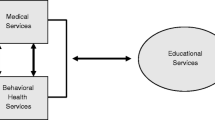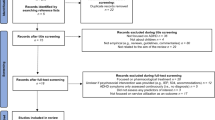Abstract
The purpose of this study was to examine youth perceptions of attention deficit hyperactivity disorder (ADHD) communication with their pediatric providers, their reported adherence to their ADHD medications, and their desired location for an ADHD educational program. Youth ages 7 through 17 with an ADHD diagnosis were recruited. A research associate interviewed the youth. Parents completed demographic questionnaires. Seventy families participated. One-third of the youth wanted more discussion about ADHD with their providers during visits. The average youth had over eight questions about ADHD and its treatment. Most youth wanted to learn about ADHD at their provider’s office. Non-white and older youth were significantly more likely to be less adherent to their ADHD medications. Youth want their providers to engage them more during visits. Providers should take advantage of this interest to engage youth more in discussions regarding ADHD and its treatment during pediatric ADHD visits.
Similar content being viewed by others
References
Ahmed, R., Borst, J. M., Yong, C. W., & Aslani, P. (2014). Do parents of children with attention-deficit/hyperactivity disorder (ADHD) receive adequate information about the disorder and its treatments? A qualitative investigation. Patient preference and adherence, 8, 661–670.
Amico, K. R., Fisher, W. A., Cornman, D. H., Shuper, P. A., Redding, C. G., Konkle-Parker, D. J., et al. (2006). Visual analog scale of ART adherence: association with 3-day self-report and adherence barriers. Journal of acquired immune deficiency syndromes, 42(4), 455–459.
Badiee, J., Riggs, P. K., Rooney, A. S., Vaida, F., Grant, I., Atkinson, J. H., et al. (2012). Approaches to identifying appropriate medication adherence assessments for HIV infected individuals with comorbid bipolar disorder. AIDS patient care and STDs, 26(7), 388–394.
Berger, I., Dor, T., Nevo, Y., & Goldzweig, G. (2008). Attitudes toward attention-deficit hyperactivity disorder (ADHD) treatment: parents’ and children’s perspectives. Journal of child neurology, 23(9), 1036–1042.
Brinkman, W. B., Hartl, J., Rawe, L. M., Sucharew, H., Britto, M. T., & Epstein, J. N. (2011). Physicians’ shared decision-making behaviors in attention-deficit/hyperactivity disorder care. Archives of pediatrics & adolescent medicine, 165(11), 1013–1019.
Brinkman, W. B., Sherman, S. N., Zmitrovich, A. R., Visscher, M. O., Crosby, L. E., Phelan, K. J., et al. (2012). In their own words: adolescent views on ADHD and their evolving role managing medication. Academic pediatrics, 12(1), 53–61.
Brown, T. N., Ueno, K., Smith, C. L., Austin, N. S., & Bickman, L. (2007). Communication patterns in medical encounters for the treatment of child psychosocial problems: does pediatrician-parent concordance matter? Health communication, 21(3), 247–256.
Chen, C. Y., Gerhard, T., & Winterstein, A. G. (2009). Determinants of initial pharmacological treatment for youths with attention-deficit/hyperactivity disorder. Journal of child and adolescent psychopharmacology, 19(2), 187–195.
DosReis, S., Mychailyszyn, M. P., Evans-Lacko, S. E., Beltran, A., Riley, A. W., & Myers, M. A. (2009). The meaning of attention-deficit/hyperactivity disorder medication and parents’ initiation and continuity of treatment for their child. Journal of child and adolescent psychopharmacology, 19(4), 377–383.
Findling, R. L., Connor, D. F., Wigal, T., Eagan, C., & Onofrey, M. N. (2009). A linguistic analysis of in-office dialogue among psychiatrists, parents, and child and adolescent patients with ADHD. Journal of attention disorders, 13(1), 78–86.
Ghandour, R. M., Perry, D. F., Kogan, M. D., & Strickland, B. B. (2011). The medical home as a mediator of the relation between mental health symptoms and family burden among children with special health care needs. Academic pediatrics, 11(2), 161–169.
Hack, S., & Chow, B. (2001). Pediatric psychotropic medication compliance: a literature review and research-based suggestions for improving treatment compliance. Journal of child and adolescent psychopharmacology, 11(1), 59–67.
Hamrin, V., McCarthy, E. M., & Tyson, V. (2010). Pediatric psychotropic medication initiation and adherence: a literature review based on social exchange theory. Journal of child and adolescent psychiatric nursing : official publication of the Association of Child and Adolescent Psychiatric Nurses, Inc, 23(3), 151–172.
Ivanova, J. I., Birnbaum, H. G., Hsieh, M., Yu, A. P., Seal, B., van der Molen, T., et al. (2008). Adherence to inhaled corticosteroid use and local adverse events in persistent asthma. The American journal of managed care, 14(12), 801–809.
Mattingly, G., Surman, C. B., Mao, A. R., Eagan, C. A., Onofrey, M., & Lerner, M. (2011). Improving Communication in ADHD Care: Results from In-office Linguistic Research. CNS spectrums, 16(4), 85–94.
Nau, D. P., Steinke, D. T., Williams, L. K., Austin, R., Lafata, J. E., Divine, G., et al. (2007). Adherence analysis using visual analog scale versus claims-based estimation. The Annals of pharmacotherapy, 41(11), 1792–1797.
Pappadopulos, E., Jensen, P. S., Chait, A. R., Arnold, L. E., Swanson, J. M., Greenhill, L. L., et al. (2009). Medication adherence in the MTA: saliva methylphenidate samples versus parent report and mediating effect of concomitant behavioral treatment. Journal of the American Academy of Child and Adolescent Psychiatry, 48(5), 501–510.
Perwien, A., Hall, J., Swensen, A., & Swindle, R. (2004). Stimulant treatment patterns and compliance in children and adults with newly treated attention-deficit/hyperactivity disorder. Journal of managed care pharmacy : JMCP, 10(2), 122–129.
Pliszka, S. (2007). Practice parameter for the assessment and treatment of children and adolescents with attention-deficit/hyperactivity disorder. Journal of the American Academy of Child and Adolescent Psychiatry, 46(7), 894–921.
Sleath, B., Blalock, S., Covert, D., Stone, J. L., Skinner, A. C., Muir, K., et al. (2011). The relationship between glaucoma medication adherence, eye drop technique, and visual field defect severity. Ophthalmology, 118(12), 2398–2402.
Sleath, B., Sulzer, S. H., Carpenter, D. M., Slota, C., Gillette, C., Sayner, R., et al. (2014). Communication about ADHD and its treatment during pediatric asthma visits. Community mental health journal, 50(2), 185–192.
Spencer, T. J., Biederman, J., & Mick, E. (2007). Attention-deficit/hyperactivity disorder: diagnosis, lifespan, comorbidities, and neurobiology. Journal of pediatric psychology, 32(6), 631–642.
Winterstein, A. G., Gerhard, T., Shuster, J., Zito, J., Johnson, M., Liu, H., et al. (2008). Utilization of pharmacologic treatment in youths with attention deficit/hyperactivity disorder in Medicaid database. The Annals of pharmacotherapy, 42(1), 24–31.
Wolraich, M. L., Bard, D. E., Stein, M. T., Rushton, J. L., & O’Connor, K. G. (2010). Pediatricians’ attitudes and practices on ADHD before and after the development of ADHD pediatric practice guidelines. Journal of attention disorders, 13(6), 563–572.
Author information
Authors and Affiliations
Corresponding author
Ethics declarations
Conflict of interest
The authors declare that there is no conflict of interest regarding the publication of this paper. All authors certify responsibility for this article.
Research Involving Human and Animal Rights
The study was performed in accordance with the tenants of the Declaration of Helsinki (1964) and was HIPAA compliant. This study was approved by the University of North Carolina at Chapel Hill Institutional Review Board and was conducted with the human subjects’ understanding and consent.
Rights and permissions
About this article
Cite this article
Sleath, B., Carpenter, D.M., Sayner, R. et al. Youth Views on Communication About ADHD and Medication Adherence. Community Ment Health J 53, 438–444 (2017). https://doi.org/10.1007/s10597-016-0078-3
Received:
Accepted:
Published:
Issue Date:
DOI: https://doi.org/10.1007/s10597-016-0078-3




